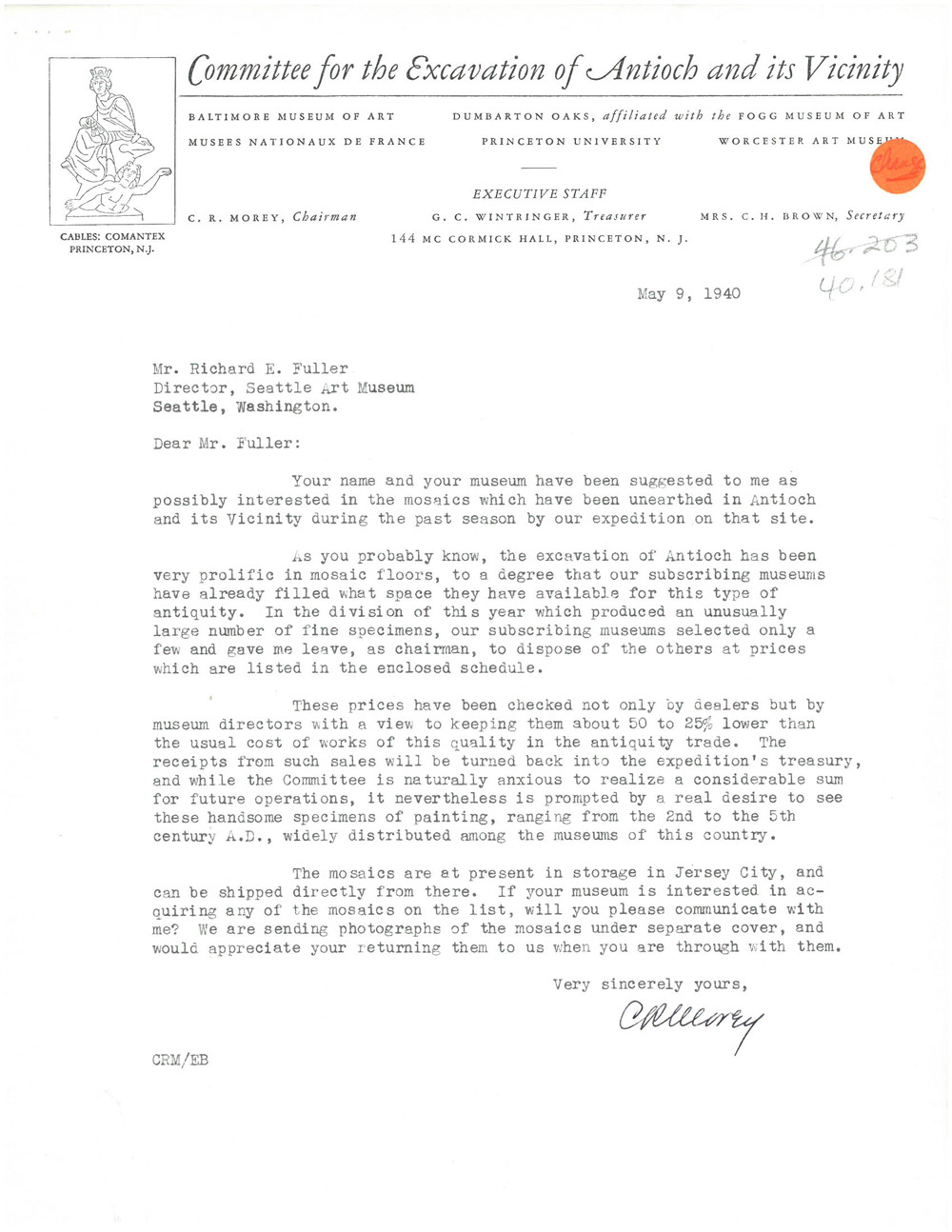Object of the Week: Mosaic from the House of Menander with Zeus
One of the things we sometimes say around here about Dr. Richard Fuller, SAM’s founding director, is that he liked to collect things he could hold in his hand, and that maybe this had something to do with his love for rocks and geology. Even while he was planning for the museum’s opening in 1933 and then seeing it through its first years, Dr. Fuller pursued his second passion at the University of Washington. He studied geology through the whole of the 1920s, first earning his bachelor’s, then his master’s, and finally his doctorate, in 1930. Beginning in 1926 he also taught part-time at UW, and that led to his being named research professor in 1940. His connections in the world of archaeology brought him a fortuitous letter that same year.
The letter, reproduced here, came from Charles Rufus “C.R.” Morey, a distinguished professor of art and archaeology at Princeton University. He had recently published a volume on excavation findings at the ancient city of Antioch (The Mosaics of Antioch, published by Longmans, Green and Co. in 1938), a book that would be one of his many contributions to the field of art history. He was also a founding member of the College Art Association, which still remembers C.R. with its annual Charles Rufus Morey Book Award.

Writing on behalf of the Committee for the Excavation of Antioch and its Vicinity, Morey offers Dr. Fuller and the Seattle Art Museum its pick of recently excavated mosaics. As Morey explains, they’re offered at bargain prices—25% to 50% off! Now, one of the reasons I feel a real kinship to Dr. Fuller is that he was always looking for a deal. He was wealthy, but not so wealthy, he figured, that he didn’t need to be smart with his resources and to push them as far as they would go. Thankfully for SAM, Dr. Fuller saw in Morey’s letter a great opportunity to build the museum’s collection of antiquities.
Dr. Fuller responded in a letter dated May 27, 1940, that the museum would like to purchase one item, the “fragment of the Sea God,” adding that he wished to “express our appreciation of the generous opportunity which you present for our participation in the extremely important excavations of your committee.” In SAM’s annual report for 1940, Dr. Fuller describes the chosen mosaic as a “very vigorous portrayal of Neptune.” This is the mosaic now hanging in our ancient art galleries on the fourth floor, titled Mosaic from the House of Menander with Zeus.
Later scholars have identified the main figure as Zeus, and not Neptune, but I would say that he’s very vigorous, indeed. He is seated on a throne, grasping a scepter in his left hand and reaching outward with his right. A halo or nimbus encircles his head and symbolizes his divinity. Almost unbelievably, SAM’s mosaic once formed part of the floor of a luxurious urban villa, about five miles outside of Antioch. Because they were durable and allowed for color and decoration, mosaics were actually used quite often as pavements in former provinces of the Roman Empire. I’ll speak for myself here, but my feet are totally unfit to tread on this, and I’m glad it’s hanging on the museum’s wall instead.
—Jeffrey Carlson, SAM Collections Coordinator
